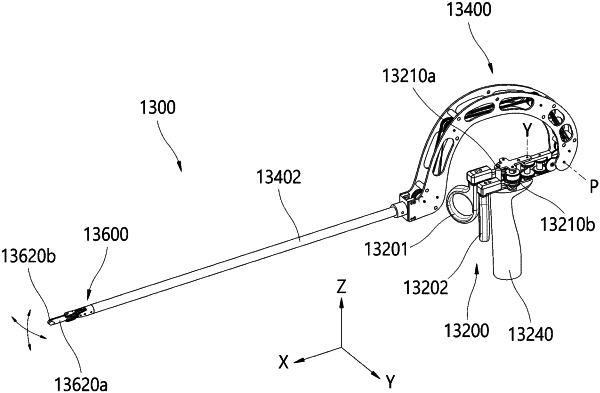| CPC A61B 34/71 (2016.02) [A61B 17/00234 (2013.01); A61B 17/2909 (2013.01); A61B 2017/00323 (2013.01); A61B 2017/00424 (2013.01); A61B 2017/00438 (2013.01); A61B 2017/00477 (2013.01); A61B 2017/00738 (2013.01); A61B 2017/291 (2013.01); A61B 2017/294 (2013.01); A61B 2017/2904 (2013.01); A61B 2017/2908 (2013.01); A61B 2017/2911 (2013.01); A61B 2017/2923 (2013.01); A61B 2017/2944 (2013.01)] | 10 Claims |

|
1. A surgical instrument comprising:
a handle for receiving a user input for manipulating the instrument, wherein the handle includes a first handle member configured to rotate along a first input axis and a second handle member configured to rotate along a second input axis, wherein the first handle member includes a first elongated portion and the second handle member includes a second elongated portion, and the handle has an input angle defined by an angular relationship of the two elongated portions;
an end-effector for performing a surgical operation, wherein the end-effector includes a first jaw member and a second jaw member, each configured to rotate along an output axis,
wherein the first jaw member includes a first contact surface and the second jaw member includes a second contact surface, the first contact surface and the second contact surface are configured to face each other, and the end-effector has a closed configuration when the two surfaces are contacted to each other or an open configuration when the two surfaces are separated to each other; and
a pulley-wire mechanism for coupling, operatively, the handle and the end-effector, wherein the mechanism includes a first input pulley operatively connected to the first handle member, a first output pulley operatively connected to the first jaw member and operatively coupled to the first input pulley via a first wire, a second input pulley operatively connected to the second handle member, and a second output pulley operatively connected to the second jaw member and operatively coupled to the second input pulley via a second wire; and
wherein when the handle has the input angle being greater than a first predetermined angle, the end-effector has the open configuration and the user input inducing a rotation of at least one of the two handle members changes an angle between the two contact surfaces, and
when the handle has the input angle being smaller than the first predetermined angle, the end effector has the closed configuration and the user input inducing a rotation of at least one of the two handle members changes a pressure between the two contact surfaces.
|